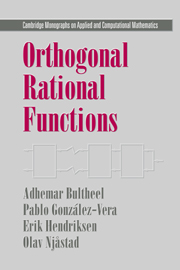Book contents
- Frontmatter
- Contents
- List of symbols
- Introduction
- 1 Preliminaries
- 2 The fundamental spaces
- 3 The kernel functions
- 4 Recurrence and second kind functions
- 5 Para-orthogonality and quadrature
- 6 Interpolation
- 7 Density of the rational functions
- 8 Favard theorems
- 9 Convergence
- 10 Moment problems
- 11 The boundary case
- 12 Some applications
- Conclusion
- Bibliography
- Index
6 - Interpolation
Published online by Cambridge University Press: 22 October 2009
- Frontmatter
- Contents
- List of symbols
- Introduction
- 1 Preliminaries
- 2 The fundamental spaces
- 3 The kernel functions
- 4 Recurrence and second kind functions
- 5 Para-orthogonality and quadrature
- 6 Interpolation
- 7 Density of the rational functions
- 8 Favard theorems
- 9 Convergence
- 10 Moment problems
- 11 The boundary case
- 12 Some applications
- Conclusion
- Bibliography
- Index
Summary
In this chapter we discuss several aspects related to interpolation. In the first section, we derive some simple interpolation properties that can be easily obtained from the properties of the functions of the second kind that were studied earlier. It also turns out that interpolation of the positive real function Ωμ, whose Riesz–Herglotz–Nevanlinna measure μ is the measure that we used for the inner product, will imply that in Ln the measure can be replaced by the rational Riesz–Herglotz–Nevanlinna measure for the interpolant without changing the inner product. Some general theorems in this connection will be proved in Section 6.2. This will be important for the constructive proof of the Favard theorems to be discussed in Chapter 8. We then resume the interpolation results that can be obtained with the reproducing kernels and some functions that are in a sense reproducing kernels of the second kind.
We then show the connection with the algorithm of Nevanlinna–Pick in Section 6.4. This algorithm provides an alternative way to find the coefficients for the recurrence of the reproducing kernels that we gave in Section 3.2, without explicitly generating the kernels themselves. If all the interpolation points are at the origin, then the algorithm reduces to the Schur algorithm. It was designed originally to check whether a given function is in the Schur class. It basically generates a sequence of Schur functions by Möbius transforms and extractions of zeros.
- Type
- Chapter
- Information
- Orthogonal Rational Functions , pp. 121 - 148Publisher: Cambridge University PressPrint publication year: 1999

